Hot Soup in the Morning
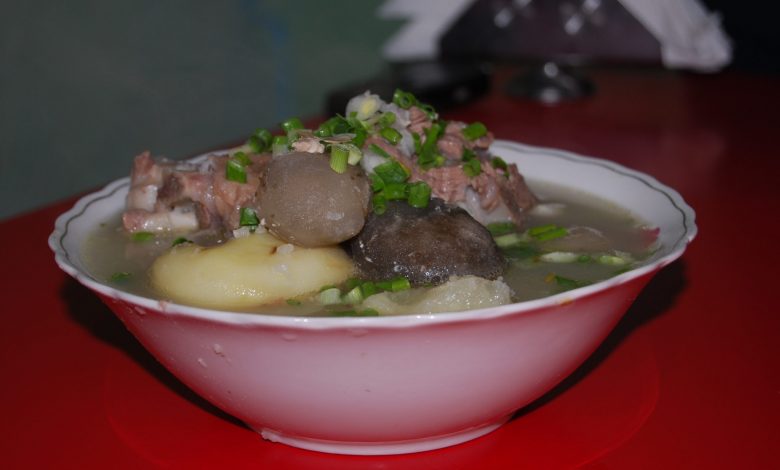
Cold feels omnipresent in hills and valleys around Cuzco, and especially now that the night time temperatures begin their irresistible march towards freezing and below. It will not be long before over night frost will pull its bucket of paint and switch the hillsides from green to brown.
In the day, when the sun shines, temperatures soar and people can shed their extra skins, but in the shadows or when a burst of air comes down the hillsides cold can strike the unprepared.
Cold is so real and so feared that at moments of transition, such as from night to day, or at the beginning or end of a meal, people drink something hot, or eat a good soup.
As dawn approaches Cuzco’s bus terminal, and even afterwards, Cuzqueños line up on benches outside, caps tight on their heads and coats well zipped. The benches are small and low to the ground, but people huddle on them, a hot bowl of soup in their hand.
You can feel the warmth chasing away the cold from their hands and its liquid soothing and enlivening their body from the inside out, like a small but intense furnace. The steam bathes their face and lets them breathe as they bend over it, almost in worship.

Opposite from where the buses pull into their berths, women sell hot soup and people gather to have a bowl, pulling the whole potatoes from the broth and eating them, or gnawing strips of chicken from off a leg or thigh, before sipping away the meaty broth.
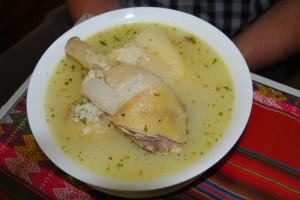
While the vendors of more standard Latin American breakfasts–coffee and bread– have only a few customers, the soup ladies can hardly keep up with the demand for their hot china bowls, steam rising toward the face like hot breath.
Soup for breakfast is a Cuzco tradition. Cafes and restaurants meet the urban standard . It is more driven by Europe and the idea of a continental breakfast of hot coffee, fresh bread, and something sweet like strawberry marmalade.
People do have that kind of breakfast, but soup seems even more common. It has its roots in the countryside where a broth cooked from different kinds of potatoes is a wake-me-up and a fortifier for the day.
On Cuzco´s streets in the morning you will see people sitting on corners or even in the middle of blocks, hunched on benches around a woman with a big aluminum pot swathed in insulating cloth. Before them are bowls of soup with potatoes and various meats, from sheep to beef to chicken, the workers’ breakfast.
While the Spanish certainly brought to Peru their own rich tradition of soups–nourished by the encounter of Europe and the Maghreb– the Inca and their ancestors had their own tradition of soups which made the dish even more important.
According to Kerlin Nonaljuca, boiling was the most important cooking technique the Incas had. But this is probably not because of the simplicity of it, nor is it because they lacked other techniques, but because of the way a broth carried heat and nutrition to the body. The broth, filled with different boiled ingredients, still is important today.
As a result, Peru has a wide variety of soups. There are the creole standards that are spread throughout the country, such as dieta, sopa criolla, or sopa a la minuta, that appear over and over on restaurant menus in Cuzco and even make their way to Peruvian restaurants abroad.
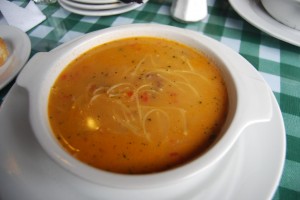
The dieta is a basic, but savory, chicken soup. The criolla involves finely diced beef, angel hair pasta, and milk. The sopa a la minuta is similar to the criolla but also includes tomato.
These are the standards and justifiably so, since they are generally delicious and satisfying. But this triad of standard creole soups is only the entry way. A world of soups lays beyond.
There are cremas, purees of various vegetables, lawas, which are similar thick soups but made from corn, chuño (a freeze dried potato), or some other thick, starchy vegetable, chairo a squash and chuño soup, adobo made from pork and chicha, and chupes more substantial soups such as the justifiably famous chupe de camarones or shrimp bisque.
Soup constitutes the first course of most Peruvian meals which to be complete include a soup and a second, a “main dish”. The set meal specials, often called menu just to confuse the tourists who use that word for what Peruvians call la carta, emphasize the importance of soup and the almost endless variety of soups possible.
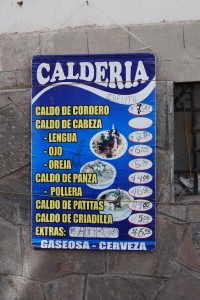
Away from the tourist area — the colonial core of Cuzco — one can find simple restaurants focusing on soups, called calderías. Along with chicherías–where chicha and extras (individual dishes without an accompanying soup), the calderías form the heart of non-tourist Cuzco.
In the mornings they fill with families who have come for a special occasion broth filled with different potatoes and other vegetable, as well as different meats. These can be of chicken, lamb, or beef. But they often are of different cuts that one generally finds popular int he US, such as patas (knuckles), tongue, and eye.
When my colleagues and I went to a caldería around the corner from the Rosaspata market other guests were fascinated with a “tourist” eating there. “Almost never”, they said, “do we see tourists here with the people.” One man in particular was very concerned that I have a good experience and made sure I ordered what he thought was the best soup in the house, lengua, which came with half a tongue attached to a sheep’s jaw.
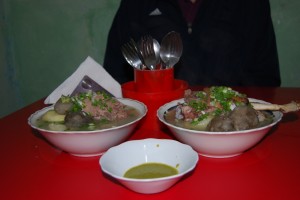
The bowls of soup–my colleagues had mutton soup and a knuckle soup– were ample and filling. As soon as we were almost done, the server grabbed our bowls and refilled them. We went away filled and satisfied, fortified for the day.
Though the sun shines intensely and was the subject of Inca worship, still cold is something that concerns people. The worry if people do not protect themselves against it, that it could take them over and make them ill. While there are many ways in which they do so, a hot and rich broth in the morning, or evening, as well as before them “main” course of the midday meal is one of the main ways. And it is almost a devotion.




